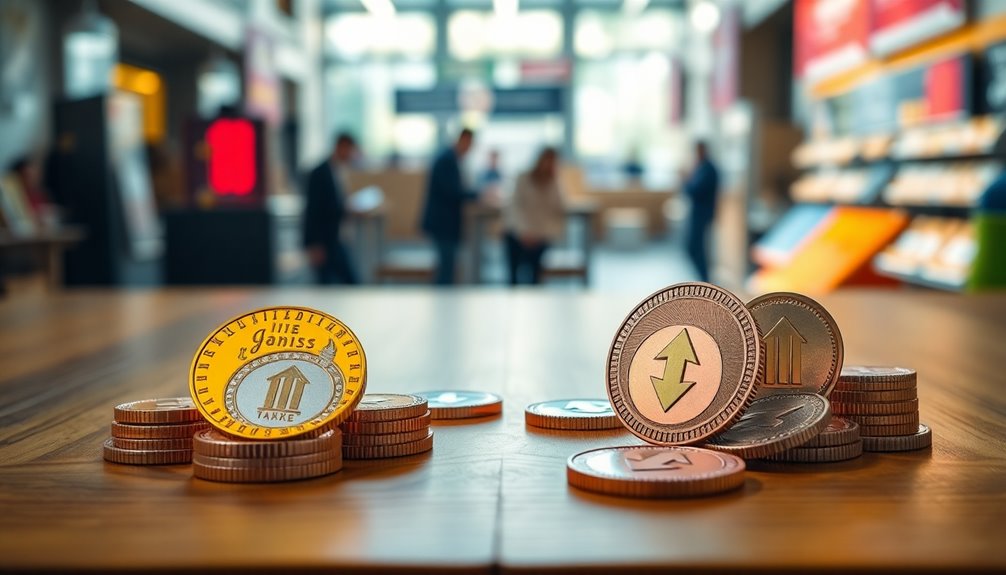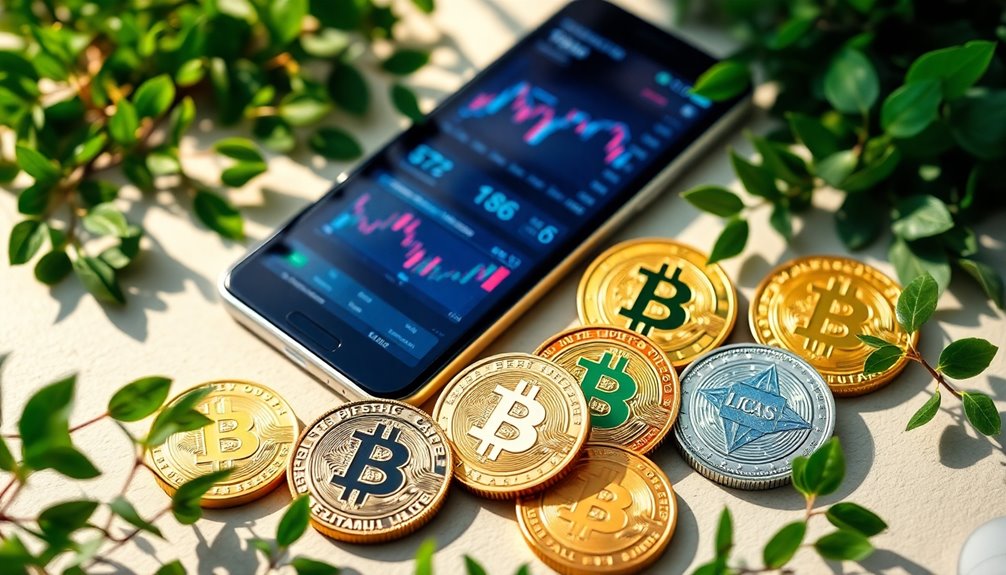If you're exploring alternative cryptocurrencies, pay attention to five noteworthy options: Cardano, with its strong community support; Solana, known for its fast transactions; Polkadot, which excels in interoperability; Chainlink, leading in oracle technology; and Avalanche, praised for its scalability. Each of these coins shows promise in terms of utility and technological innovation. With increasing institutional adoption and a projected rise in the crypto market cap, now's the time to diversify beyond Bitcoin and Ethereum. Interested in how these altcoins can fit into your investment strategy? There's plenty more to uncover about their unique opportunities and risks.
Key Takeaways
- Ethereum (ETH): Continues to lead in smart contracts and DeFi innovations, playing a pivotal role in the growing decentralized economy.
- Cardano (ADA): Known for its strong developer community and focus on scalability, sustainability, and interoperability in blockchain technology.
- Solana (SOL): Gaining traction with its high throughput and low transaction costs, making it a favored option for decentralized applications and NFTs.
- Polkadot (DOT): Enables different blockchains to interoperate, enhancing scalability and functionality across various networks in the crypto space.
- Chainlink (LINK): A key player in providing decentralized oracles, bridging real-world data to smart contracts, essential for DeFi applications.
Key Concepts Overview

When diving into the world of alternative cryptocurrencies, understanding key concepts is essential for navigating this diverse landscape.
Altcoins, any cryptocurrencies other than Bitcoin, number over 16,500 as of December 2024. Notable examples include Ethereum, DOGE, and XRP, each serving various use cases, from decentralized applications to transactions.
Ethereum holds nearly 20% of the market cap, while Bitcoin dominates with over half. Additionally, the largest altcoin is crucial to understanding the competitive landscape of cryptocurrencies.
When investing, you should evaluate a coin's utility, developer support, and alignment with your values. Additionally, reviewing the project's white paper can reveal key goals and potential red flags.
With so many options, grasping these foundational concepts will help you make informed decisions in your crypto journey.
Market Dynamics and Innovations

As the cryptocurrency landscape evolves, market dynamics and innovations are shaping the future of altcoins in exciting ways.
You'll notice institutional adoption increasing, driven by regulatory clarity that enhances market stability. Expect to see more cryptocurrency ETFs, including those for Solana and XRP, which could lead to an anticipated altcoin season. This is further supported by the fact that high institutional adoption rates have been observed, with firms like BlackRock significantly increasing their Bitcoin holdings.
Technological advancements like AI integration and layer 2 solutions are also transforming how you interact with crypto. Real-world asset tokenization is revolutionizing traditional finance, making investments more accessible.
With the projected growth of stablecoins exceeding $400 billion by 2025, and Ethereum and Solana showing strong performance, now’s the time to pay attention to these emerging trends in the altcoin market. As the demand for digital assets continues to surge, investors are increasingly drawn to altcoins with high return potential. Innovations in blockchain technology, particularly from projects like Ethereum and Solana, are revolutionizing the landscape, enabling faster transactions and more scalable solutions. By strategically diversifying portfolios with carefully selected altcoins, savvy investors can capitalize on these market shifts and maximize their returns.
Mechanisms of Cryptocurrency Transactions

Understanding the mechanisms behind cryptocurrency transactions is crucial for anyone looking to navigate this digital landscape.
It all starts with your wallet application, where you enter the recipient's wallet address, the amount to send, and your digital signature created with your private key. Once signed, the transaction details are broadcast to the entire blockchain network.
Nodes verify the transaction by checking your digital signature and balance, placing valid transactions in a mempool. Cryptographic encryption secures transaction data, ensuring confidentiality and protection against unauthorized access.
Miners or validators then select these transactions to create a new block. Consensus mechanisms like Proof of Work or Proof of Stake ensure all nodes agree on transaction validity, preventing double-spending.
Security measures, including encryption and multi-signature wallets, protect your transactions from unauthorized access.
Pros and Cons Analysis

While alternative cryptocurrencies offer exciting opportunities, they also come with their share of risks and challenges. You can benefit from decentralized applications and tokenized securities, which promise efficiency and transparency.
However, the liquidity of smaller altcoins can be a concern, as larger coins dominate trading volumes. Moreover, regulatory hurdles may affect the approval of new cryptocurrencies, impacting their growth potential. As the crypto market cap is expected to exceed $10 trillion by 2025, this could provide a favorable environment for alternative cryptocurrencies to thrive.
While the NFT market shows signs of recovery, it's still volatile. Additionally, the rise of stablecoins could reshape the market, though they may also limit the growth prospects of other coins.
Balancing these pros and cons is essential for making informed investment decisions in this dynamic landscape.
Altcoin Performance Metrics

Altcoin performance metrics provide crucial insights for investors navigating the cryptocurrency landscape. One key metric is the Altcoin Season Index (ASI), which evaluates the performance of the top 50 altcoins against Bitcoin over a 90-day period. When 75% or more of these altcoins outperform Bitcoin, it signals an altcoin season. Additionally, tracking the Total2 Marketcap gives you a clear picture of capital distribution in the altcoin sector; rising values often indicate growing investor confidence. Combining these metrics helps you refine your trading strategies and identify market trends. The ASI's historical charts also allow you to visualize recurring patterns, empowering you to anticipate future market behaviors and make informed decisions. Understanding the Altcoin Season Index is essential for optimizing investment decisions in the volatile crypto market.
Regulatory Uncertainty Impacts Investments

Regulatory uncertainty significantly impacts investment decisions in the cryptocurrency market, creating a landscape fraught with risk and unpredictability. The absence of clear regulatory frameworks can deter you from investing, as sudden policy changes may lead to financial losses. For instance, China's 2017 ICO ban caused market turmoil that affected many investors. You'll also notice that companies allocate resources to compliance rather than innovation, hindering growth. Multiple regulatory bodies in the U.S. enforce different rules, complicating compliance. This patchwork of laws and divergent global regulations creates fragmentation, making it tough for companies to operate efficiently. As regulatory focus intensifies, you'll need to stay informed about potential changes that could impact your investments. The increasing volume of regulatory changes raises compliance costs for blockchain companies, adding to the uncertainty.
Emergence of Decentralized Finance

In an environment marked by regulatory uncertainty, the rise of decentralized finance (DeFi) offers an innovative alternative to traditional financial systems. You can engage in peer-to-peer transactions without needing a middleman, making financial services more accessible.
With just an internet connection, you can access various DeFi platforms, enjoying low fees and the ability to negotiate interest rates directly. Security and transparency are paramount, thanks to smart contracts that record transactions on the blockchain while keeping identities private. Decentralized applications (dApps) further enhance user engagement in these financial services, allowing for an array of options tailored to individual needs.
Platforms like Uniswap enable decentralized exchanges, where liquidity providers support trading. By locking funds in liquidity pools or utilizing flash loans, you can explore numerous financial services, from lending to yield farming, all designed to empower you in the evolving financial landscape.
Diversify Your Cryptocurrency Portfolio

As you navigate the dynamic world of cryptocurrencies, diversifying your portfolio can significantly enhance your investment strategy.
Start by allocating assets wisely; consider Bitcoin for stability, Ethereum for its smart contracts, and stablecoins like USDC for reduced volatility. Balance your investments across large-cap, mid-cap, and small-cap cryptocurrencies to capture various growth potentials. Effective diversification can reduce overall investment risk and help you avoid overexposure in any single asset.
Sector diversification is crucial too. Explore DeFi coins for lending opportunities and NFTs for unique digital assets.
Regularly rebalance your portfolio to maintain your desired asset allocation, and use dollar-cost averaging to manage market volatility. Implement robust security measures and stay informed about market trends and regulatory changes.
Frequently Asked Questions
What Are the Best Platforms to Buy Alternative Cryptocurrencies?
When you're looking to buy alternative cryptocurrencies, consider platforms like eToro, Coinbase, Kraken, Gate.io, and Binance.
Each of these offers user-friendly interfaces and a wide range of altcoins. eToro stands out for its leverage options, while Coinbase emphasizes security and accessibility.
Kraken provides staking rewards, Gate.io boasts a vast asset base, and Binance features low trading fees.
Choose the one that aligns best with your trading style and investment goals.
How Do I Safely Store My Altcoins?
Imagine your altcoins as precious gems hidden in a treasure chest. To keep them safe, you've got to choose the right lock.
Consider using hardware wallets like Ledger or Trezor; they act as fortified vaults. Cold storage is another solid option, ensuring your gems aren't vulnerable to online threats.
For ease of access, software wallets like Trust Wallet provide a user-friendly interface, but remember to secure them with strong passwords.
Can I Use Altcoins for Everyday Purchases?
Yes, you can use altcoins for everyday purchases! Many merchants now accept altcoins like Bitcoin Cash and Binance Coin, making transactions easier.
Stablecoins, such as Tether and USD Coin, offer stability and are popular for purchases due to their consistent value. Plus, with fast transaction speeds from altcoins like Avalanche, your payments process quickly.
Just ensure the merchant accepts the specific altcoin you want to use before making your purchase.
What Are the Tax Implications of Trading Altcoins?
When you trade altcoins, you need to understand the tax implications. Each exchange counts as a taxable event, meaning you'll report gains or losses on Form 8949 and Schedule D.
Short-term gains are taxed at ordinary income rates, while long-term gains enjoy lower rates.
Don't forget to track your transactions, as failing to report can lead to penalties. Using crypto tax software can simplify this process and help ensure compliance.
How Do I Identify Promising Altcoins for Investment?
To identify promising altcoins for investment, start by evaluating their technology—check the consensus mechanism, scalability, and security features.
Assess the market potential by looking at the use case, market demand, and competitive landscape.
Analyze the tokenomics, including total and circulating supply, distribution, and community involvement.
Finally, conduct thorough research by reading whitepapers and roadmaps to understand the project's vision and future goals.
This comprehensive approach will help you make informed decisions.
Conclusion
In today's rapidly evolving crypto landscape, keeping an eye on innovative altcoins can significantly enhance your investment strategy. Interestingly, recent data shows that over 40% of investors now consider diversifying into alternative cryptocurrencies, highlighting a shift in market sentiment. As decentralized finance continues to grow, embracing this trend could lead you to new opportunities and potential gains. So, don't miss out—explore these alternatives and strengthen your portfolio for the future!









